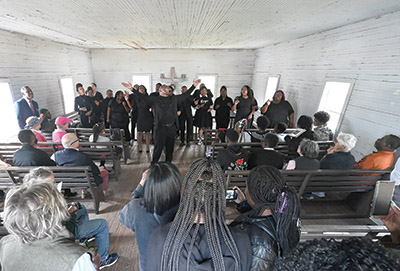History
A faith that would not die

The cypress posts long ago settled into the sandy soil. The brick pilings that replaced them crumbled. But the foundation of Friendfield Church endured.
It is, the Rev. Betty Clark said, “a faith that would not die.”
The church at Friendfield Village in Hobcaw Barony glowed in the warm winter sunlight from a coat of fresh white paint after a restoration that raised it onto new brick pilings and replaced rotten boards as about 100 people gathered to celebrate the project’s completion.
The church was built around 1890, replacing an earlier structure that had served the enslaved people who lived in Friendfield and the nearby villages since the 1840s. It was a place of worship for their descendants into the 1950s.
“It’s an opportunity for us to share that history,” said George Chastain, executive director of the Belle W. Baruch Foundation, which owns Hobcaw. “It’s only possible because the structures survive.”
The $175,000 cost of the renovations was covered by private donations.
The structures are a gateway to research into the people who lived on the former rice plantations that now comprise the 16,000 acres at Hobcaw Barony. That work is focusing on the whole span of time Friendfield was occupied.
“It’s critical for us to maintain the structures the way they were when the last individual moved out so we don’t lose that history,” Chastain said.
Along with the renovation, researchers at Francis Marion University have been at work to identify the enslaved people who lived in the villages.
“We only knew a handful of enslaved names before this project started,” said Richard Camlin, director of education at the Baruch Foundation.
The list now includes 715 names, and the work is continuing, said Steven Sims-Brewton, an associate professor at Francis Marion.
“We want this story to be as complete at possible,” he said.
One example of the challenges is Laura Carr, who lived near the church in a cabin that was built before the Civil War.
“We have always been intrigued by Laura Carr,” said Lynn Hanson, professor emerita at Francis Marion and former co-director of the Baruch Center for S.C. Studies, a partnership between the university, Coastal Carolina University and the Baruch Foundation
Lee Brockington, who retired as senior interpreter at Hobcaw, started the work on the villages and came across Carr, who was thought to have been born in 1857. She was known as a medicine woman.
“Just enough detail to make the woman intriguing,” Hanson said.
A year ago, volunteers clearing around a cemetery in another part of Hobcaw found a maker.
“It said Laura Carr had died in 1937 and she was 80 years old,” Hanson said. “This was it.”
Or maybe not.
The 1900 Census reported Carr was 55, so was born in 1844 or ’45. The 1910 Census gave her age as 52, making 1857 a likely birth year.
“There could be any number of reasons for this. The mysteries are still just as intriguing as they ever were,” Hanson said. “Maybe more so.”
Learning the 715 names was important, but it’s only a first step.
“It’s all about learning what individual lives were like; what they counted for and what they stood for,” Hanson said.
Sims-Brewton said he hoped the church restoration will be the first of many commemorations.
The work was “the restoration of a legacy left by a generation long gone,” said Valinda Littlefield, an associate professor at the University of South Carolina, who has done research at Hobcaw. “This place is also where history happened, and this place is where we can better understand trauma, resilience and beauty of African American experiences.”
A gospel choir that sang at the ceremony started out under a tent, but soon filed into the church. The crowd followed.
The last time that many people had been inside, Chastain said, “was probably 100 years ago.”
“The Black church has always served as a place for telling our story and singing our songs,” said Clark, pastor of Bethel AME Church in Georgetown. “This is the place, Friendfield Church, where we still experience a faith that would not die.”




